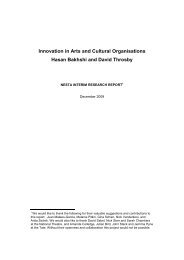Rumbling on performativity_Frits Simon
Rumbling on performativity_Frits Simon
Rumbling on performativity_Frits Simon
You also want an ePaper? Increase the reach of your titles
YUMPU automatically turns print PDFs into web optimized ePapers that Google loves.
zed by others. Without doubt the c<strong>on</strong>clusi<strong>on</strong>s and recommendati<strong>on</strong>s of the coordinati<strong>on</strong><br />
team will find its way in the missi<strong>on</strong> statement, midterm strategy development,<br />
yearly planning and evaluati<strong>on</strong>.<br />
However, claiming the outcome as a victory from <strong>on</strong>e of the discourses unintenti<strong>on</strong>ally<br />
suggests that definiti<strong>on</strong>s of situati<strong>on</strong>s can be designed in rather straight forwarded,<br />
pre-c<strong>on</strong>ceived and rati<strong>on</strong>al managed strategies. Meanwhile instituti<strong>on</strong>al policy - or<br />
the c<strong>on</strong>clusi<strong>on</strong>s and recommendati<strong>on</strong>s by the coordinati<strong>on</strong> team - appears not to be a<br />
product of well-c<strong>on</strong>sidered arguments, but a process in which many different interacti<strong>on</strong>s<br />
c<strong>on</strong>verge into c<strong>on</strong>clusi<strong>on</strong>s and recommendati<strong>on</strong>s.<br />
Self-organizing transformative processes<br />
From a complex resp<strong>on</strong>sive process-perspective something else happened. C<strong>on</strong>versing<br />
resulted in organizing and organizing developed in c<strong>on</strong>versing, as an inescapably<br />
self-organizing process (Shaw, 2002), in which under the skin several psychological<br />
mechanism did their job. The documented c<strong>on</strong>tagious aspects of the interacti<strong>on</strong><br />
am<strong>on</strong>g the members of the coordinati<strong>on</strong> team underline a self-causing character of<br />
interacti<strong>on</strong>. Given the shifts in c<strong>on</strong>clusi<strong>on</strong>s and recommendati<strong>on</strong>s which become<br />
transparent during the discussi<strong>on</strong>s in the coordinati<strong>on</strong> team, it is obvious that this<br />
self-causing character deploys a transformative causality. In line with the complexity<br />
sciences this kind of causality explains that “... entities are forming patterns of interacti<strong>on</strong><br />
and at the same time, they are being formed by these patterns of interacti<strong>on</strong>.” (Stacey,<br />
2010: 57; italics Stacey). In a comm<strong>on</strong> resp<strong>on</strong>sibility the members of the coordinati<strong>on</strong><br />
team and finally the board formed and were formed within the discussi<strong>on</strong>s c<strong>on</strong>cerning<br />
the c<strong>on</strong>clusi<strong>on</strong>s and recommendati<strong>on</strong>s, even if <strong>on</strong>ly virtually present. In reality things<br />
happen as they happen and apparently sometimes lead to logically c<strong>on</strong>tradictory results.<br />
Looking back I come to understand that given the inescapably self-organizing process<br />
of interacti<strong>on</strong> that even my co-creative input is part of a self-organizing process,<br />
which as such is not defined by co-creativeness. Paradoxes, disappointments, c<strong>on</strong>tradicti<strong>on</strong>s<br />
and compromises are unavoidably parts of the game. Despite that I know – as<br />
stated before – that we try to talk each other into <strong>on</strong>e of our own discursive perspectives<br />
<strong>on</strong> reality, in a kind of naiveté I still supposed that my co-creative discursive input<br />
would lead to co-creative results, away “ ... from c<strong>on</strong>flict and fragmentati<strong>on</strong> to the good<br />
as the cohesi<strong>on</strong> of shared visi<strong>on</strong> and joint purpose.” (Shaw, 2002, p.155; italics Shaw).<br />
Seemingly still with fear to have no c<strong>on</strong>trol as a programme manager (Groot, 2010b).<br />
The peculiar thing for me is that being a Foucault-adept it should have been obvious to<br />
me that my co-creative input is part of a discourse that as any discourse must be seen<br />
“... as an expressi<strong>on</strong> of violence we put <strong>on</strong> things, or in any case as something tangible<br />
we lay up<strong>on</strong> them.” (Foucault, 1971: 42). Unnoticed I hoped that <strong>on</strong> another level of the<br />
playing field I stealthily could c<strong>on</strong>vince my colleagues to become co-creati<strong>on</strong>ists. I<br />
understand now that also co-creati<strong>on</strong>ists are not protected from using epistemological<br />
including power strategies, even if they are aware of the whereabouts of that kind<br />
of strategies.<br />
4. Sense making in and of the internal branding project | 109



